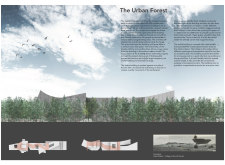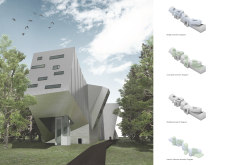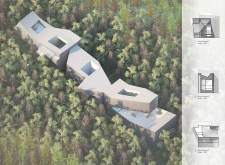5 key facts about this project
At the core of this design is a strong commitment to bridging the gap between built structures and natural settings. The project features a dynamic form that pushes against the site's boundaries, emphasizing a connection to the topography and biology of the forest. The building's design encourages exploration by offering a sequence of engaging spaces, allowing visitors to experience the architecture alongside the forest's natural beauty. Key elements of the design include courtyards and various viewing platforms that promote interaction with both the architecture and the surrounding environment.
The material selection is a critical aspect of the design, with an emphasis on durability and harmony with the natural surroundings. Concrete is prominently used for structural integrity and is complemented by metal panels that provide a contemporary aesthetic while withstanding the elements. Expansive glass openings are a defining feature, promoting transparency and drawing in natural light, effectively blurring the lines between inside and outside. The inclusion of wood elements contributes warmth and a connection to nature, enhancing the overall tactile experience of the interior spaces. Additionally, landscape plantings are integrated into the design to further merge the building with its natural context, reinforcing ecological sustainability.
Unique design approaches in "The Urban Forest" are characterized by its systematic organization and the interplay of spaces. The layout incorporates varying heights and forms, encouraging a fluid movement through the building while maintaining clear visual and spatial connections to the forest. The innovative use of isometric diagrams illustrates the careful arrangement of these spaces, highlighting how circulation patterns are designed to enhance visitor engagement and interaction. This thoughtful consideration of spatial dynamics ultimately shapes the experience of the building not just as a destination but as part of the wider landscape narrative.
The project exemplifies contemporary architectural ideas that prioritize environmental awareness and community connectivity. By incorporating multifunctionality and encouraging visitor interaction with nature, "The Urban Forest" establishes itself as a model for future architectural endeavors in similar settings. Individuals interested in understanding the full depth of this architectural project are encouraged to explore its presentation further, reviewing architectural plans, sections, and detailed designs that provide richer insights into this significant architectural undertaking. Through deeper engagement with the project's design elements, one can fully appreciate how it seeks to enhance the visitor experience within the beautiful confines of Kemeri National Park.


























